Volvo Super Olympian
The Volvo Super Olympian was a low-floor double-decker bus manufactured by Volvo. It replaced the 3-axle version of Volvo Olympian. The chassis had the designated manufacturer code B10TL.
| Volvo B10TL Super Olympian | |
|---|---|
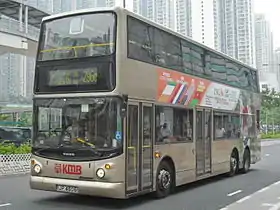 Kowloon Motor Bus Alexander ALX500-bodied Volvo Super Olympian in July 2008 | |
| Overview | |
| Manufacturer | Volvo |
| Production | 1998–2004 |
| Assembly | Irvine, Scotland Wrocław, Poland |
| Body and chassis | |
| Doors | 2 doors |
| Floor type | Low entry/Low floor |
| Powertrain | |
| Engine | Volvo D10A285 |
| Power output | 285 hp |
| Transmission | Voith DIWA/ZF Ecomat |
| Dimensions | |
| Length | 10.6 and 12.0 metres |
| Width | 2.50 and 2.55 metres |
| Height | 4.40 metres |
| Chronology | |
| Predecessor | Tri-axle Volvo Olympian |
| Successor | Volvo B9TL |
History
The Volvo Super Olympian was unveiled in 1998, with one chassis being sent to Hong Kong for a motor show held by International Union of Public Transport in the same year. The chassis was later returned to the United Kingdom.
Chassis design
The Super Olympian chassis was based on the Volvo Olympian. The front radiator was moved behind the front axle on the 12 metre version, or in front of the second axle for the 10.6 metre version (due to its shorter wheelbase). In order to lower the chassis further, the assisted steering function of the middle axle was cancelled. The suspension system has also been largely modified so that it is electronically controlled instead of moving passively. One special feature is that after turning, the suspension unit does not return to normal, remaining tilted to either the left or right, until the bus becomes stationary.
An option for 11.3 metre length of Super Olympian was also available, but no orders were received. The Super Olympian was powered by the Volvo D10A285 (Euro II or Euro III), with a maximum power of 285 hp (213 kW). Its somewhat insufficient engine power has earned some mildly derisive nicknames in Hong Kong. The most common are "豬" (pig), "扒" (meat cutlet) and "豬扒" (pork chop, derived from the pronunciation of the word "Super").
Initially, the Super Olympian chassis were built in Volvo's factory in Irvine, Scotland. After the closure of the factory in mid-2000, production was moved to Wrocław, Poland.
Hong Kong
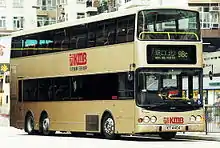
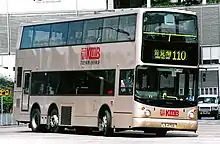
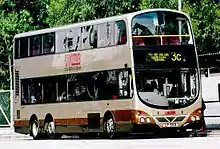
12m version
Kowloon Motor Bus ordered the first batch of 61 (3ASV1-61) Alexander ALX500-bodied B10TL Super Olympians with ZF 4HP590 transmission, and roller shuttle route displays in 1998. These entered service in 1998/99. All except the prototype 3ASV3 had narrow 2+2 seats on the upper deck. All Super Olympians with plastic signs were retired in November 2017.
A further 80 Super Olympians (3ASV62-141) entered service in 2000/01. These buses have electronic route displays and ZF 5HP590 transmission. 3ASV78 was the 3,000th Alexander bodied bus supplied to KMB, and 3ASV141 was the first KMB bus to meet Euro III emission standards.
The last 351 Super Olympians (3ASV142-492), including 21 which were fitted with Australian Volgren CR223LD bodywork, entered service in 2001/02. All of these buses had their chassis built in Poland. Their D10A285 engines were built to meet Euro III emission standards and had aluminium alloy front wheels supplied by Alcoa. 3ASV297 was coated with special metallic paint, which shows different colours (mainly green and purple), depending on the angle of light reflection. The last Volgren-bodied Super Olympian (3ASV474) was retired on 11 November 2020, while the last Alexander ALX500-bodied Super Olympian (3ASV492) was retired on 19 December 2020.
10.6m version
Kowloon Motor Bus was the only operator of 10.6 metre Super Olympians. The first 49 (ASV1-49) 10.6m Alexander ALX500 bodied Super Olympians were introduced in 2001. They are equipped with D10A285 Euro II engines and had Alcoa front wheels.
ASV50, which was put into service in 2002, is a prototype short-wheelbase Super Olympian (chassis built in 1999), and also the only short-wheelbase Super Olympian built in Scotland. It is equipped with a Euro II D10A285 engine and ZF 4HP590 transmission rather than the previous 5HP590 as fitted to older ASVs.
ASV51-100 were also equipped with the Euro III D10A285 engines. They are almost identical with ASV1-49, except for minor interior differences. Only the first 24 were put into service in 2003. The remaining 26 were stored for more than a year due to SARS, and the 26 were put into service between September 2004 and March 2005.
The last 10.6 metre Super Olympian and Alexander ALX500 (ASV100) was retired on 8 March 2023, which means that there are no more 10.6 metre Super Olympians and Alexander ALX500s in Hong Kong.
12m wider version
In January 2003, Kowloon Motor Bus received the first Wright-bodied Super Olympian with a 2.55 metre-wide body (once known as the Wright Explorer). Like the Alexander Dennis Enviro500, it featured a straight staircase and plug exit door. It was numbered AVW1 and was registered on 20 March 2003.
The next 49 buses (AVW2-50) with a slightly different design followed shortly after AVW1, they entered service in 2003/04. The last 50 buses (AVW51-100), which are almost identical, entered service in 2004/05, These were the last batch of Volvo Super Olympian ordered by KMB. The last Super Olympian (AVW92) was retired on 31 July 2023, which means that there are no more Volvo Super Olympians in Hong Kong.
New World First Bus
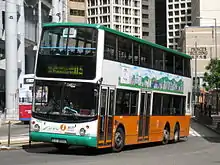
New World First Bus bought 103 Super Olympians in five batches, all are 12 metres long and were fitted with Alexander ALX500 bodies.
The first 40 (5001-5040), fitted with electronic route displays, were introduced in 1999. The next 20 (5041-5060), with their side route number boxes moved to a lower position, entered service in 2000/01. The chassis of 5060 was the first to be built in Poland. New World First Bus began de-registering the buses on 21 November 2017.
The next 19 Super Olympians (5061-5079), with Euro III D10A285 engines and Alcoa front wheels, entered service in 2001. To mark the occasion of meeting the Euro III emission standard, New World First Bus designed a full body advertisement for one of them (fleet number 5070) to state that they were environmentally friendly. They were followed by 10 similar examples (5080-5089) later that year. Among these buses, 5080-5086 had their registration numbers originated from ex China Motor Bus buses and service cars.
The last batch of 14 Super Olympians (5090-5103), entered service in 2002, had their rear electronic route number displays raised above the emergency window to form a box, the design being unique among all similar vehicles in Hong Kong. These were all withdrawn and were either sold to Citybus, converted to a training bus or headed to the scrapyard.
The last three buses in the fleet (5072, 5076, 5079) had been retired on 27 August 2019. These were the last buses to have no headrest in franchised service.
Singapore
.jpg.webp)
In late 1999, Volvo delivered one Volgren CR222LD-bodied Super Olympian to the then Singapore Bus Service for trial purposes.[1] It was Singapore's first low floor "Superbus", and had advanced specifications at time of introduction. Originally deployed on routes serving the then new Sengkang New Town, it was transferred to Ang Mo Kio bus depot in 2004. This bus was burnt in a depot fire in 2010, and was subsequently written off.[2]
Satisfied with the trial, SBS purchased 51 Volvo Super Olympians in 2000. These buses were the last to be ordered by SBS prior to their rebranding to SBS Transit. 50 were bodied with an updated Volgren CR222LD bodywork, with one entering service in April 2002 and the remaining buses entering service in early 2003.[1] They were also the first buses to be registered with the new SBS Transit livery. One bus was built completely by Volgren in Australia, and hence equipped with a Transit Media electronic destination signage (EDS). The rest, which were assembled locally, debuted with plastic destination signages initially and were retrofitted with LECIP electronic destination displays in 2012. All buses of this batch had served out of Ang Mo Kio, Toa Payoh and Bedok North depots throughout their lifespan.[3] While most units have since been scrapped between April and June 2020, two units are currently preserved. One unit has been exported to Hong Kong for preservation,[4] while the other unit is currently preserved and repurposed at a special education school in Singapore.[5]
In early 2005, the last Volvo Super Olympian, debuted with a prototype ComfortDelGro Engineering (CDGE) bodywork,[1] which later form the basis of the subsequent first batch of Volvo B9TLs debuting in the following year. Originally deployed to Bukit Batok depot, it was transferred to Toa Payoh depot in 2012, where it was refurbished with yellow seats and its original Transit Media EDS replaced with a LECIP EDS. It is also the last non-wheelchair accessible bus in Singapore. It was taken out of revenue service at the end of 2020, and scrapped together with 33 Volvo B9TL double deckers between April and June 2021 due to poor quality and performance.
Replacement
Production of the Volvo Super Olympian ended in 2004 and 2005 after completion of the last order from Kowloon Motor Bus and SBS Transit. Its successor was the Volvo B9TL.
References
- Davis, Michael C.; Phillips, Ron (2006). Singapore Buses Volume 1 Singapore Bus Service Part 2. United Kingdom: DTS Publishing. pp. 94–95, 98–101, 111. ISBN 9781900515269.
- "Volvo B10TL". Land Transport Guru. 1 January 2018. Retrieved 17 September 2019.
- "Volvo B10TL (Volgren)". Land Transport Guru. 15 January 2018. Retrieved 17 September 2019.
- "前新加坡SBST Super Olympian抵港". hkitalk.net. 3 August 2020.
- "SBS9817C – The Preserved Volvo B10TL Bus in Singapore". Land Transport Guru. 5 December 2020.
External links
![]() Media related to Volvo Super Olympian at Wikimedia Commons
Media related to Volvo Super Olympian at Wikimedia Commons